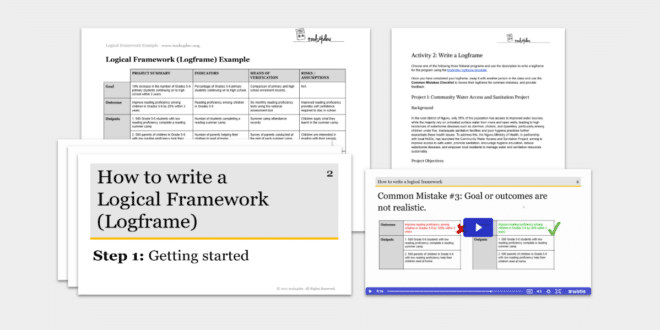This comprehensive lesson plan provides all the resources needed to teach the fundamentals of writing a logical framework. The material can be delivered as a single 1-hour lesson or divided into multiple sessions with practical activities.
Kit Contents
The kit includes:
- Slides: PowerPoint and PDF formats for all sections.
- Videos: Presentations of all sections.
- Templates: Logical framework in Word format.
- Examples: Completed logical framework.
- Checklist: A “Common Mistakes” checklist in Word and PDF formats.
- Activities: Suggested activities for completion as individual or group projects.
Learning Objectives
By the end of the lesson students will be able to:
- Understand the prerequisites for creating a logical framework.
- Understand the differences between a logical framework, logic model and theory of change, and what each is used for.
- Identify the parts, and typical format, of a logical framework.
- Understand how logical framework formats vary between organisations and donors.
- Describe the goal, outcomes, outputs and activities of a program in a logical framework format.
- Identify indicators and means of verification for each goal, outcome, output and activity.
- Identify risk and assumptions at each level in the logical framework, and understand the importance of risks and assumptions.
- Identify and avoid common mistakes when writing a logical framework.
Duration
The content can be delivered as a single 1-hour lesson or divided into multiple sessions with practical activities.
Content Overview
The lesson plan includes the following topics:
Fundamentals
- Step 1: Getting Started: Understand the prerequisites for creating a logical framework, the typical format, and variations between organisations.
- Step 2: Goal, Outcomes, Outputs and Activities: Learn how to describe the logic of a program in the logical framework format.
- Step 3: Indicators and Verification: Identify the indicators and means of verification for each level in the logical framework.
- Step 4: Risks and Assumptions: Identify the risks and assumptions that must be true in order for the program logic to be successful.
Template and Example Frameworks
A sample logical framework template and a completed example for reference.
Common Mistakes
Review a practical example of a logical framework, learn to identify and correct common errors, and use a checklist to refine your framework.
Sector-Specific Tips
Practical activities for use in a classroom. The activities can be completed individually or in small groups.


